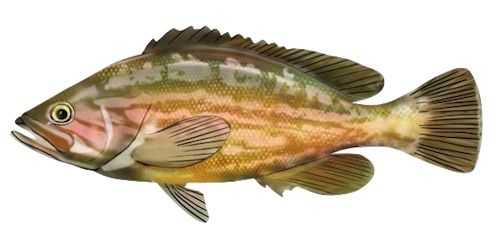Comb Grouper

Species Details
Mycteroperca Acutirostris
Serranidae
Perciformes
Onshore, Nearshore, Offshore, Reef
8 - 22 lbs.
12" - 31"
Comb Grouper (Mycteroperca acutirostris) Fish Description
The comb grouper typically has a brown-gray color with splotches of white spots dotted around its body. The presence of three to four dark brown lines from its eye stretch along the lower part of its body and appear as dark wavy stripes. The comb grouper’s anterior and posterior nostrils vary in proportions, and its lower jaw projects further than the upper jaw.
This fish has 11 dorsal spines with 15-17 soft dorsal rays that follow the shape of its body towards the caudal fin. Its median fins are darker and may have white spots or lines. It has an elongated and laterally compressed body. The comb group grouper is often misidentified as the mottled grouper (Mycteroperca rubra) and the island groper (Mycteroperca fusca).
Diet & Size
Not much is known about this fish for it hasn’t been thoroughly researched, but educated guesses point to its diet consisting of smaller fish, crustaceans, and plankton.
The average size of an adult comb grouper is around 32 inches with a weight of about 9 pounds, a small fish but generally around the same size as a red grouper or gag grouper. The International Game Fish Association records the all-tackle record at 11lbs 9oz.
Interesting facts about the Comb Grouper
- Comb groupers feign to be on the verge of death by lying on their side and twitching to attract prey
- Juveniles mimic the behavior of the black-ear wrasse to disguise themselves from prey
- Some records in Brazil have labeled the comb grouper as the mottled grouper
- They are not suited for long-distance travel or fast-swimming
- Grouper in the Philippines are called lapu-lapu, the name of a Filipino hero and a city in the province of Cebu
How To Catch a Comb Grouper
The comb grouper is sometimes sought-after as a game fish in some Brazilian waters but not in the Gulf of Mexico. It’s usually fished for as food by local fishermen and is frequently caught in May. Others report its abundance in September to October during spawning.
Some local anglers indicate that Longboat Pass and Pilot Cove (Florida, USA), Enseada de Port (Santa Catarina, Brazil), and Enseada de Botafogo (Rio de Janeiro, Brazil) are prime spots to hook a comb grouper. Bottom-fishing and fly-fishing are common tactics used by anglers when fishing for groupers.
The comb grouper’s migratory patterns and fishing methods are gathered mostly from local fishermen in Brazil. These fish are usually caught for the local market with small boats and a regular hook and line. Spearfishing is used to catch juveniles, despite the 9-inch minimum size limit in Brazil.
The lack of data on the comb grouper can lead to a possibility that this species may be vulnerable, despite The International Union for Conservation of Nature certifying it as being of Least Concern. Their high prices in traditional markets make them attractive to locals, even though they aren’t commercially fished.
Habitat and Distribution
The comb grouper is a subtropical reef-associated fish, dwelling at depths of approximately 3 - 150 feet. They are distributed along the warmer waters of the Western Atlantic, on the shores of Texas (USA), Florida (USA), the northwestern Gulf of Mexico to Venezuela, Bermuda, and most commonly in Brazil.
This inshore fish lives in brackish and marine waters at the lower end of the water column. Adults live in coastal reefs with rocky beds and are found grouped in schools that contain several dozen fish. Juvenile comb groupers are found in grass beds, mangrove areas, and shallow waters near soft corals and coral reefs. The young have been reported in intertidal rocky shores in South Brazil, and those less than one-inch long may be found among the flotsam.
Research on the reproductive patterns of the comb grouper are sparse, but it has been hypothesized that they spawn from September to December in Brazilian waters. Juveniles are identified by having a small black saddle on the top of their tail base, and they become sexually mature when they reach a weight of 4 pounds.
The comb grouper are usually spotted feeding in mid-water depths, often during daybreak and nightfall. Adults have been observed hunting in schools of sardines and have been seen to follow goldspot eels to feed on crustaceans disturbed by the latter’s foraging.







